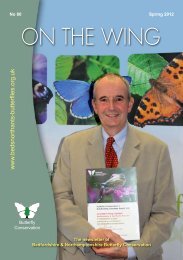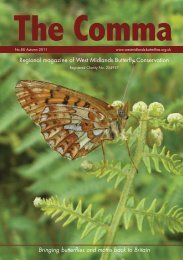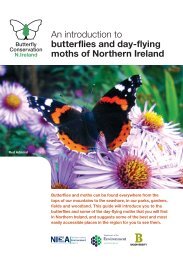EIG newsletter - Butterfly Conservation
EIG newsletter - Butterfly Conservation
EIG newsletter - Butterfly Conservation
You also want an ePaper? Increase the reach of your titles
YUMPU automatically turns print PDFs into web optimized ePapers that Google loves.
A tendency to Pessimism: The Probable extinction of Danube Clouded<br />
Yellow from Hungary and Central Europe in the near future<br />
One of the last Danube Clouded Yellows (Colias myrmidone) in<br />
Bavaria, Germany. Photo: Mario Maier<br />
The Danube Clouded Yellow – Colias myrmidone is one<br />
of the most endangered butterflies in Europe. The Red<br />
Data Book of European Butterflies 4 treats it as SPEC1,<br />
as the distribution of the species is concentrated in<br />
Europe (although it is not certain whether the Asian<br />
population belongs to a distinct subspecies). It recently<br />
has become extinct in some countries in Western<br />
Europe, and is in strong decline within its entire range,<br />
except some populations in Romania. The status in<br />
Ukraine, Moldova, Belarus and the European part of<br />
Russia is unknown.<br />
It was once common and relatively widespread in all Central Europe and just penetrated<br />
Western Europe along the River Danube (hence the name). It inhabited large warm grasslands,<br />
forest-steppes, open meadows on calceorous hillsides and sand-dunes where both the<br />
foodplants of the caterpillars (several Broom species – Cytisus spp.) and also flowery meadows,<br />
were present.<br />
The imago, like other Clouded Yellows, requires large areas, as both males and females can fly<br />
several kilometres at a furious speed without stopping for nectaring or to rest on the low<br />
vegetation. The egglaying behaviour also requires dense patches of foodplant, within the flying<br />
range of the females, and they have a special preference for tall, sun exposed flowering shoots,<br />
as have the caterpillars.<br />
Danube Clouded Yellow was once common on the huge Sand-dunes of the Great Hungarian<br />
Plain. This forest-steppe mosaic habitat complex was once ideal for several very rare butterflies<br />
such as False Ringlet – Coenonympha oedippus, which inhabited the wet meadow system<br />
between the dunes and the flood-plain forests near the Danube. Alcon Blue – Maculinea alcon<br />
and Scarce Large Blue – Maculinea telejus are among the species, which have survived the<br />
habitat reduction caused by the drainage and intensive agriculture. However there are other<br />
examples where the butterflies were not so lucky. Nathaniel Charles Rothschild once studied<br />
the ecology of Esper’s Marbled White – Melanargia russae in the same habitat complex, but the<br />
species became extinct long ago in Hungary since its original habitats, the oligotrophic<br />
grasslands and clearings in the Peszér Forest have been drained dry and afforested with False<br />
Acacia – Robinia pseudoacacia or turned into arable crops. Something similar has happened to<br />
the habitats of Danube Clouded Yellow. Large open areas can still be found where some would<br />
expect the presence of this beautiful butterfly, but if you try to find the food plant, very few can<br />
be found on the sand-dunes or the forest edges. The livestock, which once swarmed these<br />
meadows, have disappeared as traditional agriculture has been replaced by intensive meat and<br />
milk production in the late 1950s and early 1960s. The soil structure has changed, succession<br />
has taken place, the open sandy grasslands gradually growing higher and the pioneer habitat<br />
suitable for Cytisus slowly vanishing.<br />
4 van Swaay, C. & Warren, M.S. (1999). Red Data Book of European butterflies (Rhopalocers). Council of Europe, Strasbourg (Nature and<br />
Environment Series No. 99)<br />
15







